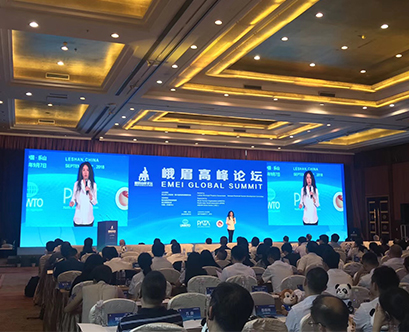
近60年前,“大跃进”(Great Leap Forward)的目标之一是“15年内钢铁产量超过英国”。如今在“去产能”的大背景下,许多钢铁企业停产,济南钢铁就是其中之一。《经济学人》称此次“去产能”为“大跃退”(Great Leap Backward)。文章讲述了大背景下一个小人物的命运。
“去产能”:全球经济富有争议的最大趋势之一

译者:武守晗
校对:倪凌晖
策划:刘 璠
Capacity cuts in China fuel a commodity rally and a debate
“去产能”:全球经济富有争议的最大趋势之一
本文选自The Economist | 取经号原创翻译
关注 取经号,回复关键词“外刊”
获取《经济学人》等原版外刊获得方法
One of the biggest, and more controversial trends, in the global economy
Sep 7th 2017 | JINAN
STEEL ran in Zhang Cheng’s family for three generations. His grandfather mined iron ore. His father got a job in the big state-owned steel mill just outside Jinan, capital of Shandong province. His mother worked in the on-site hospital. And Mr Zhang went to the mill-run school, graduating to a job in its foundry, where, in the heat of the blast furnace, he rolled metal into thin bars for construction. But after nearly two decades in Jinan Steel, he worked his last day there this summer. In the name of “capacity reduction”—a government policy to rein in excess production of steel—the plant stopped operating in July, and Mr Zhang went on the dole.
张诚(音)家三代从事铁矿业。他的爷爷从事铁矿开采工作;他的父亲在济南郊外的一家大型国有钢铁厂工作;他的母亲在钢铁厂医院工作。张诚自幼在钢铁厂开办的学校上学,毕业后就在这家钢铁厂的铸钢厂工作。在高炉的高温下,他把钢铁轧成施工用的钢筋。但在济南钢铁厂工作近二十年后,今年夏天张诚站完了最后一班岗。为了抑制钢铁产能的过剩,政府出台了“去产能”政策,于是七月钢铁厂停产,张诚下岗了。
Since they worked for a state-owned company, the local government has helped him and the 20,000 others who lost jobs find new ones. But it has been a struggle for Mr Zhang, a soft-spoken man. Openings in Jinan are mainly in the service industry—as a waiter in restaurants or an attendant at a station on the new underground. He worries that he does not have what it takes. “I’ve spent my life interacting with machines, not with people,” he says.
因为曾在国企工作,当地政府帮助张诚还有其他失去工作的2万人找到新的岗位。但对性格温和的张诚来说,这是一个挑战。济南目前空缺的职位主要是服务行业,诸如餐厅的服务员,还有新建地铁站的服务人员。他担心自己不能胜任这些工作。“我前半辈子都在和机器打交道,而不是和人。”张诚说道。
That China has persisted in cutting capacity in heavy industry, even at the cost of pushing people out of their jobs, has been one of the biggest but also more controversial trends in the global economy over the past year. It is big because of China’s sheer heft: the country produces nearly as much coal and steel as the rest of the world combined, and even more aluminium and cement. American and European companies have in the past accused China of swamping their markets with cheap metals. But more recently they have benefited as China’s efforts to curb production have fuelled a run-up in prices. But then there is the controversy: doubts about whether the capacity cuts are all they are cracked up to be.
尽管有许多人被迫失业,但中国政府任然坚持在重工业领域进行“去产能”。这是过去一年来全球经济中具有争议的最大趋势之一。它的大体现在中国经济在全球的巨大影响力上:中国的煤炭和钢铁产量几乎相当于其他国家产量之和,中国铝和水泥的产量甚至比其他国家的总产量还要多。美国和欧洲的公司过去曾经指责中国倾销——用低价占领市场。但最近,由于中国的“去产能”政策,金属价格价格回升,这些公司也因此受益。但任然存在一些争议:中国的“去产能”政策真的就像它宣传得那样只是为了“去产能”吗?
The cuts are certainly ambitious. By 2020 the government aims to reduce the country’s annual capacity for coal production by 800m tonnes, or roughly 25% of what it made last year; its steel capacity by 100m-150m tonnes, nearly 20% of its output in 2016; and its aluminium capacity by 30% in big production centres. When Mao Zedong launched his catastrophic “Great Leap Forward” in 1958, he insisted that within 15 years China would produce more steel than Britain. China’s new campaign amounts to a Great Leap Backward: it wants to eliminate steel capacity equal to 15 times that of Britain.
中国政府对削减过剩产能无疑是雄心勃勃的。到2020年,政府的目标是将煤炭年产能减少8亿吨,约占去年产能的25%。减少钢铁产能1亿-1.5亿吨,占2016年产能的近20%; 减少大型铝生产中心30%的产能。毛泽东在1958年发动灾难性的“大跃进”时,他坚信,在15年内,中国的钢铁产量将赶超英国。中国的“去产能”政策相当于新时代的“大跃退”:它想要削减掉的钢铁产能相当于英国的15倍。
When the government unveiled its plans last year, the natural response was scepticism. Yes, authorities had taken to talking tough: Li Keqiang, the premier, said that economic reforms would be “like taking a knife to one’s flesh”. But for years they had promised capacity cuts that never materialised. With local officials judged to a large extent on their area’s GDP growth, they had every incentive to pay lip-service to reducing capacity, while quietly allowing new investment. By the World Steel Association’s count, almost half of the steel policies announced by China from 1990 to 2016 were focused on limiting capacity. Yet China’s steel mills mushroomed and their capacity-utilisation rate fell from nearly 90% in 2006 to less than 70% a decade later.
当政府去年推出这一计划时,外界的自然反应当然是怀疑。确实,中国政府喜欢摆出强硬的姿态。李克强总理说,经济改革要有“壮士断腕的精神”。但多年来“去产能”却从未实现。由于地方官员的政绩评定在很大程度上基于该地区的GDP增长,他们口头上宣称全力以赴推进“去产能”,同时悄悄地引进新的投资。据世界钢铁协会的统计,1990年至2016年中国实行的近一半钢铁政策都侧重于限制产能。然而,中国的钢铁厂数量却出现了增长,产能利用率从2006年的近90%下降到2016年的70%以下。
lip service if sb pays lip service to sth, they say that they approve of it or support it, without proving their support by what they actually do 口惠而实不至
Nearly 18 months into the latest bout of capacity cuts, China has made believers of many investors and analysts. The official numbers show it to be well ahead of schedule. And for those who doubt those data, two other indicators—price and profit—show that Chinese heavy industry is much healthier than just a short while ago. Coal and steel prices have more than doubled since the start of 2016. Producers of both, in the red for much of the past half-decade, have seen their fortunes improve markedly. Their profits have surged.
最近一次“去产能”已经推行了近18个月,中国政府已经让许多投资者和分析师相信这次是来真的了。官方数字显示,“去产能”的完成情况要比预计得好。而对于那些怀疑这些数据的人来说,他们可以看看另外两个指标——价格和利润。这两个指标显示中国重工业的健康状况在短短数个月有了显著的提高。煤炭和钢铁价格自2016年年初以来已经翻了一番以上。在过去五十年,有大部分时间,这些煤炭和钢铁厂都在亏损运营。如今它们的盈利情况有了大幅的改善,盈利迅速上升。
Demanding questions
This, however, does not entirely settle the controversy. As in any market, commodity prices are determined by supply and demand. At the same time as China has closed steel mills and halted work at coal mines, demand for their products has strengthened, thanks to a property-market rally and the government’s sustained splurge on infrastructure. This suggests that the price rises reflect not just the elimination of unused capacity but also greater use of what had been deemed excessive. The coal industry is the best example. Last year the government ordered mines to cap their production at 276 days, trying to put a lid on supply; this year, it let them increase that to 330 days.
然而,这些并不能完全平息争议。在任何一个市场环境下,商品价格是由供需决定的。中国关闭钢厂,抑制煤矿开采。与此同时,由于房地产市场的反弹和政府对基础设施持续大力的投资,市场对钢铁的需求增加。这表明价格上涨不仅反映了过剩产能的削减,更反映了被视为过剩的产品实际有着巨大的需求。煤炭行业就是最好的例子。去年,政府规定煤炭企业一年最多生产276天,试图减少供应; 今年允许生产的天数增加到330天。
In China this has ignited a heated debate about whether the economy is on the cusp of a new growth cycle. Proponents argue that the rebound in industrial profits has allowed companies to repair damaged balance-sheets, and that the cuts in capacity are laying the groundwork for an eventual recovery in investment in production facilities. Others counter that a slowdown in the property market, visible in recent weeks, will spell an end to the recovery in demand, and reveal that current industrial capacity remains more than sufficient. At least some of the run-up in metal prices does appear to be excessive. At a meeting in August, the China Iron and Steel Association, an industry body, accused speculators of trying to exploit uncertainty about capacity cuts.
在中国,这引发了一场关于经济是否处于新的增长周期的热烈争论。支持者认为,产业利润的反弹使得企业能够扭转亏损的局面,“去产能”为生产设备投资的最终复苏奠定了基础。其他人则反驳说,最近几周房地产市场放缓。这意味着需求复苏的终结。这也表明:目前产能任然过剩。至少有一些金属价格上涨是过度的。在八月份的一个会议上,中国钢铁协会指责投机者试图利用“去产能”的不确定性。
This points to a separate concern about the nature of China’s capacity cuts: low prices ought to have signalled to companies that it was time to curtail production, but it took top-down orders from the government to get them to act. Wang Tao of UBS, a bank, describes the successes to date as a testament to policy implementation: “It is difficult to say that market behaviour has really changed.” In the coal industry, officials are struggling to find the right balance, aiming to restrain prices after their initial efforts drove them up. “It’s like a car fishtailing,” says Laban Yu of Jefferies, an investment bank. After skidding a bit, a driver with some luck and skill can get his vehicle straight again.
这又点出了人们对于“去产能”的另一关注点:低价格本来应该向公司发出一个信号——现在应该减少生产了,但是最后还是等到政府下达命令,“去产能”才自上而下地实现。瑞士联合银行(UBS)的王涛(音)认为,迄今“去产能”所取得的成果表明政策得到了切实的实施。他说:“很难说市场行为是否已经真正发生了改变”。在煤炭行业,官员们正愁着如何维持价格平衡。经过他们的努力,“去产能”初有成效,煤炭价格上升,但他们要做的却恰恰是要抑制上涨的价格。投资银行富瑞(Jefferies)的Laban Yu说:“这就像一辆汽车摆尾,在稍稍侧滑后,司机需要一些运气再加上技能才能让车辆再次回到直线行使。”
fishtail / ˈfɪʃteɪl / if a vehicle fishtails , the back end slides from side to side.汽车侧滑,摆尾
Clownish as that might sound, there is a chilling subtext for global competitors. Putting a lid on capacity ought also to put a lid on China’s exports. But another aspect of China’s campaign is to replace outdated plants with more modern ones. In the steel sector, China has already amassed some of the world’s most technologically advanced facilities. It is likely to emerge from this round of capacity cuts with even better steel mills, giving it a bigger share of the high-end market.
这可能听起来有些滑稽,但全球钢铁企业的境况并不乐观。“去产能”意味着出口的减少。而中国“去产能”政策的另一面是用更现代工厂替代落后的工厂。在钢铁行业,中国已经拥有了世界上最先进的设备。经过这一轮的“去产能”,中国很可能会拥有更好的钢铁厂,使其在高端市场占有更大的份额。
clownish like a clown ; silly 滑稽的
The closure of Jinan Steel, where Mr Zhang worked, has been touted in the state press as an example of China’s seriousness in cutting capacity. It may in fact be a better example of industrial upgrading. One option the company has given laid-off workers is to move 300km (186 miles) to the east, to the city of Rizhao, where its parent group, Shandong Steel, just opened a state-of-the-art plant. The expected output of the Rizhao mill is a touch higher than the Jinan mill. Shandong Steel, in other words, appears to be replacing capacity, not cutting it. But that is cold comfort for Mr Zhang: for its new production lines, the company wants younger workers, especially those with university degrees.
官媒鼓吹:济南钢铁厂的停产体现了“去产能”的决心。实际上这更体现了中国的工业升级。济南钢铁厂给下岗职工的一个选择是到济南东边300公里(186英里)的日照市就职。在那里,济南钢铁厂的母公司山东钢铁刚刚开设了一个装有尖端设备的工厂。日照钢厂的预期产量比济南钢厂略高。换句话说,山东钢铁似乎正在升级产能而不是削减产能。但这对张诚来说并没有什么意义。因为公司希望年轻的工人在这天新生产线上工作,特别是那些具有大学学历的工人。












